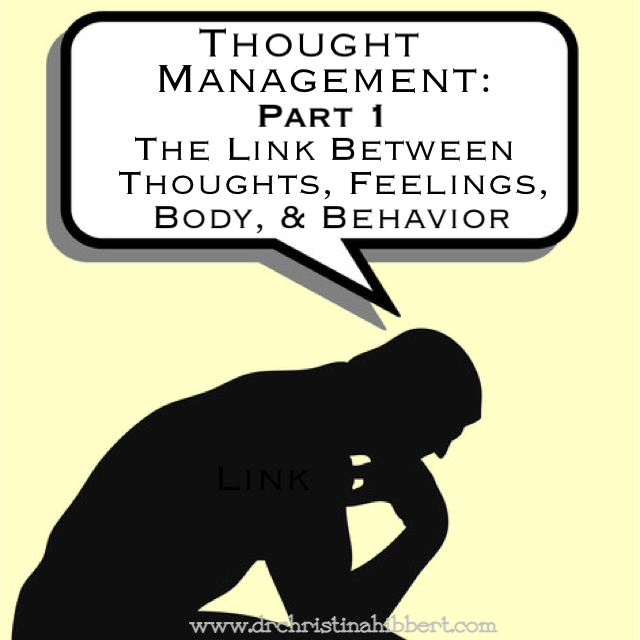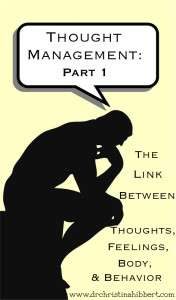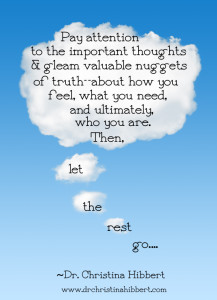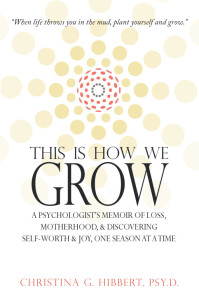
07 May Thought Management: Part 1
The Link Between Thoughts, Feelings, Body, and Behavior
One of the best tools I’ve learned as a psychologist, mom, and human being is how to understand and change my thoughts. It’s estimated that humans have an average of 60,000 thoughts per day! Were you aware you were thinking so much? Probably not, for a vast majority of these thoughts are what are called “Automatic Thoughts”—they come automatically, without any conscious effort on our part, and most of the time we don’t even hear them. The problem is that our thoughts are linked to our bodily reactions, emotions, and behaviors. Even thoughts we don’t intend or want can set off a cycle of sensations, emotions and behavioral reactions, leaving us feeling out of control. But learning to see the connection between thoughts, feelings, bodily responses, and behaviors empowers us.
The Thought Cycle
Allow me to explain how this works. Life gives us situations. For example, I am walking through the forest when I see a bear. An automatic thought arises, “Ah! There’s a bear!” This thought creates a physiological response: my blood pressure rises, pulse increases, heart rate speeds up, and adrenaline pumps through my body. Almost simultaneously there is an emotion, or several emotions. Facing the bear I feel anxiety, panic, and fear; I then engage in a behavior. In this case, I run away from the bear. (Now, I have learned recently that the best thing to do when encountering a bear is actually not to run away, but for the sake of this example, we will ignore that little fact). Let’s say I run away to safety. What is my next thought? Perhaps, “Wow! I am safe! Way to go, me! Whew!” And my body’s response is for my parasympathetic nervous system to kick in, my heart rate slows, pulse lowers, and breathing resumes a more natural pattern. I have some emotions—joy, relief, satisfaction! And my next behavior? I go out for an ice-cream cone to celebrate my success!
But let’s say I’ve been raised to believe I am good-for-nothing—I am a wimp, I overreact, I always run away from my problems. In this case, after I find myself safely out of the bear’s reach, my thoughts might sound like, “You are such a wimp! Why did you run? It was just a small bear. You probably could have taken it! Why are you always such a coward?” My body’s response would be to keep the cortisol and adrenaline flowing, my stomach would become upset from tension, and my breathing would remain fast and shallow. My emotions might include frustration, anger, disappointment, and self-loathing. And my behavior? I would go and eat an entire carton of ice-cream as form of self-punishment.
This is Aaron Beck’s cognitive-behavioral theory in a nutshell. We can see that not only are thoughts, feelings, the body, and behaviors connected; they are influenced by the thoughts, feelings, reactions and behaviors of our past. And once we can see this cycle, we have a choice: to either ignore what we see, or to listen and intervene when we hear something that doesn’t quite make sense.
Case Example
My own classic example comes from when I was in graduate school. Here I was, two kids, my husband in dental school, attending a full-time doctoral program, working part-time as a fitness instructor, and obviously surviving on very little sleep. One day I came home to a surprisingly empty house. My husband, OJ, had picked up the boys on his way home and taken them to the park, and I had 2 blessed hours alone. I immediately started cleaning, trying to remedy the bomb of Superman capes, lion’s tails made of belts, Scooby-Doo bowls and silly straws, that covered what once had been our living room and kitchen. It wasn’t until I dug into the pile of dirty clothes to start several loads of laundry that I noticed my body was tense, my frustration mounting higher than the pile before me, and I heard a sing-song voice within say, “I can’t handle this! I’m going to freak out!”
“Wait a minute,” I said to myself, “I heard that! What exactly can’t I handle?” It was the first time I had heard my automatic thoughts and stopped to question them. I was just doing laundry, so why was I so frustrated? After a few moments of listening I heard my answer, “I’m exhausted. I have a quiet home. I want to take a nap, and instead I have to clean and do laundry.” Well, did I have to do the laundry right then? No. It was a choice I had made. So, I decided to unmake that choice and instead choose to take a nap. Sure, the house was still a mess when my family came home, but the difference was that I was no longer a mess.
Can you see the power that listening to and altering your thoughts can have on your life? Through practice we can train ourselves to pay attention to the important thoughts and gleam valuable nuggets of truth—about how we feel, what we need, and ultimately, who we are. Then, we can let the rest go.
Of course, it’s hard to do at first; like any new skill it takes practice to hear, challenge, and change unhealthy thoughts. So it’s best to start small. I suggest if this is new to you that you start by simply trying to hear what you tell yourself in stressful, overwhelming, or even supremely joyful times. Begin to notice the impact your thoughts are having on your life.
Set Yourself Free
It takes time to master your thinking, but believe me, it is well worth the effort. I still use these valuable skills every single day, and I’m teaching them to my children now too. I hope you will join me for part II of my “Thoughts” series, where we will learn to use a Thought Record, and begin to challenge the thoughts that you will, by then, be so much better at hearing. Stick with us as we learn the powerful skill of managing our thinking and discovering the truth of how we feel, behave, and the truth of who we are. After all, you know what they say: “The truth shall set you free.” It will. I assure you. It will.
Questions? Comments? I’d love your “thoughts” (pun intended!), so leave a comment below!
Click Here for “Thought Management, Part 2—
How to Change Your Thoughts (& Your Life) Using a Thought Record!” (plus video)
Be sure to check out Dr. Hibbert’s Amazon Bestseller, This is How We Grow–
available now at Amazon or Barnes & Noble!
Pre-order Who Am I Without You at Amazon, Barnes & Noble, New Harbinger, Target, or your local bookseller!
Coming March 1, 2015!
You may manage your subscription options from your profile.
Don’t miss a thing!
SUBSCRIBE, above, “like” my Facebook pages (Dr. Christina Hibbert; This Is How We Grow), and follow me on Twitter,Pinterest, & Instagram!
Related Posts/Articles:
Join my Free, Online “This Is How We Grow” Personal Growth Group!
Daily Mindfulness: 6 Ways to Put More “Being” into what you’re “Doing
The Mind-Body-Spirit Connection
The Pyramid of Self-Worth: How to FEEL Self-Esteem
Spring Cleaning for the Soul: 18 Ways to Be Happy, Healthy, & Sane
5 Reasons Self-Esteem is a Myth
If Self-Esteem is a Myth, then What is the Truth?: Understanding Self-Worth
Self-Esteem vs. Self-Worth: Q&A with Dr. Christina Hibbert
“Sleep Better, Cope Better”: 6 Insomnia Causes & Cures
How to NOT Be Ungrateful: 10 Things for Which I am NOT Ungrateful






Sounds like this is going to be an excellent series. You are right on target when you say that our thoughts, even, or especially, out automatic thoughts, are connected to our feelings and behaviors. I’m tweeting and going to take the series.
Excellent! Thank you, Elaine. As Dr. Wayne Dyer has said, “Change your thoughts, change your world”. Here’s hoping we can all “change our worlds” one thought at a time:). Part 2 coming soon!
Excellent exert. Made stop and think about my own life. I think it’s time for change or I’ll end up being eaten b the bears of the corporate world,and I will only have myself to blame.
So glad it inspired you to want to make some changes. Best of luck!
[…] of the best tools I’ve ever learned for stress management (check out my article on “Thought Management”). This helps me see what my mind is saying and gives me the opportunity to turn it into […]
Thought Management; It seems to reason that if As a man thinketh, so is he that As a leader thinketh, so is his followers. We are daily bombarded with negativity and keeping positive is not something that you can be passive about. Passive is always overtaken, overwhelmed or over extended.
Yes! The same principle definitely applies to leadership skills. Leaders especially need to understand the link between their thoughts, feelings, body and behaviors in order to take charge and inspire people in the most productive ways possible!
Ooh I’ll be giving the thought diary a try! I’ve stumbled across your site today and have seen some inspiring ideas on other pages too. The examples above are really clear. Thanks, Helen
[…] how your thinking affects your body, feelings, and behaviors. Start noticing the thoughts running through your mind […]